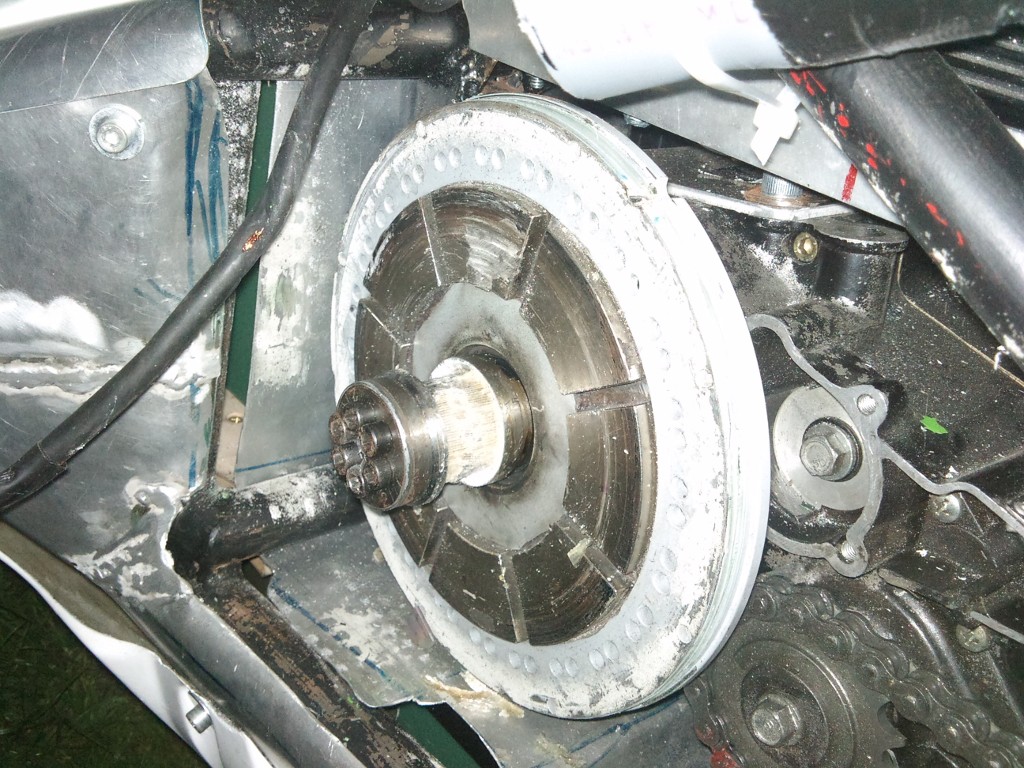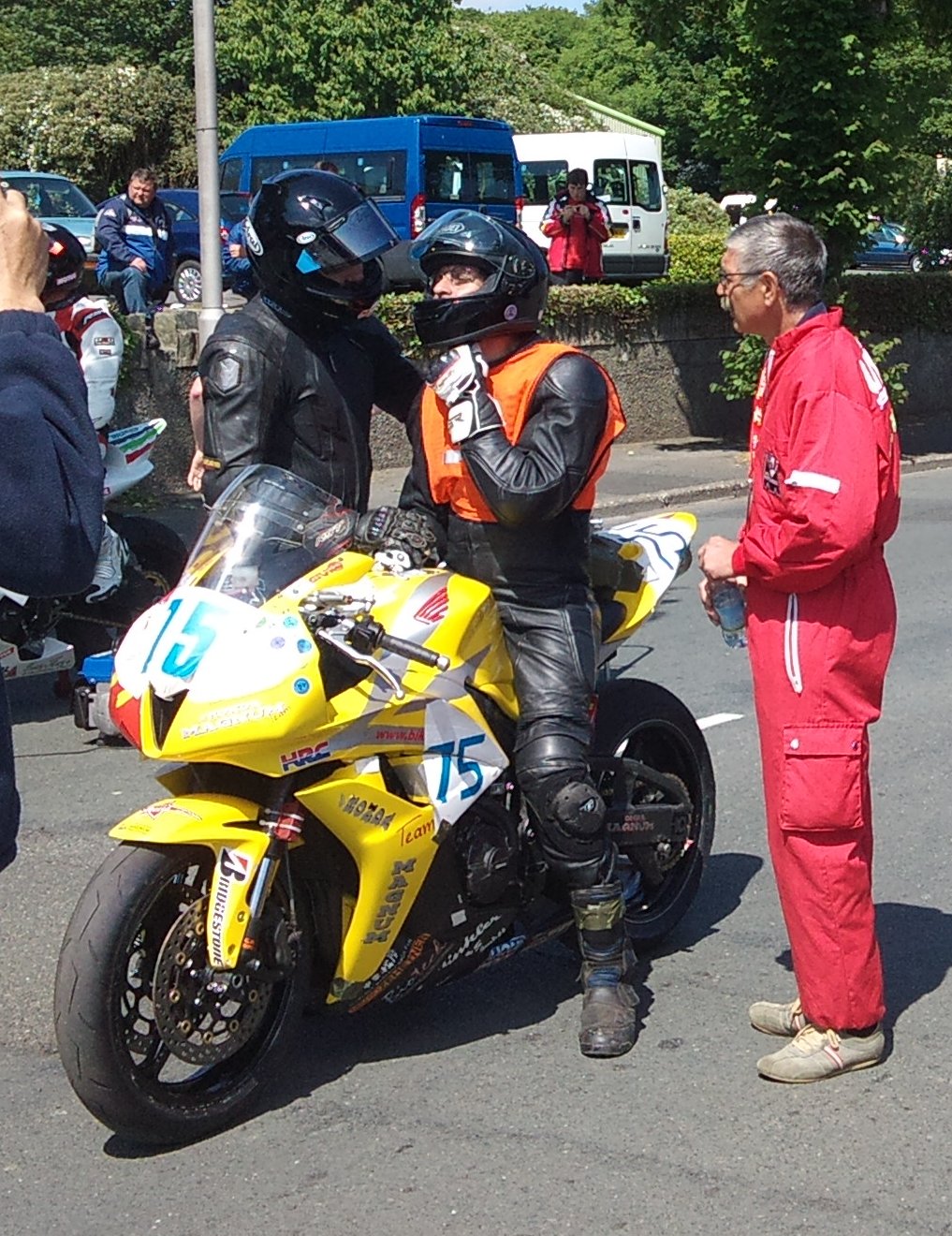PAST
It all started in the ninetees of the last century when Christian Reichenwallner, an ambitious
TGM student made a somewhat strange proposal to his lector Martin Loicht. He was thinking
about a lightweight motorbike powered by an electric motor. The ulterior motive of the student was
rather simple: he knew lots about the enthusiasm of his lector refering to motorcycles.
The bike was built rather quickly and performed as it should. Despite its small size,
the acceleration was impressive. On the other hand top speed was poor. At this point Martin started
to think about a reasonable design of a high performance motorcycle solely powered
by an electric engine.

Martin Loicht on his record breaking E-bike "Hermes" at Austrian Military Airbase Langenlebarn (1999).
This bike's framework was built up of reynolds steel tubes, TIG welded in a Chevallier welding jig.
The engine was a brushed Lynch Ltd. DC disk motor,
fully redesigned, carrying a glass roving reinforced rotor and a machined stator housing, full of
double layer neodymium magnets. The maximum power output of this engine was about 65 bhp at 6200 rpm and 120 Volts. Normally after
two minutes at throttle wide open the commutator housing became weak, because of exessive generation of heat.
In the last consequence the carbon brushes or the rotor failed totally. We made lots of attempts, trying to cool down the
brush sleeves, testing different kinds of coolants more or less sucessfully...
Unfortunately our well-behaved world record engine was destroyed by human curiosity during some mainenance business
but that's an other story.


Another blown engine. The rotor of this engine decided to seperate from its hub (IOM TTXGP 2009).
A right shifted five gear box was connected to the electric motor by a dry clutch and simplex primary chain. This configuration
worked reliably and caused never any problems.
The space normally incorporating a combustion engine was stuffed up with rather heavy lead batteries.
The controller made by Curtiss Ltd. can manage up to 1000 amps without any problems. A dam'n good piece of oldfashioned analogue
electronics, normally on duty in electric omnibusses.
The fairing was made of patches of 1,0 milimeters AlMg3 and also TIG welded to one masterpiece by Martin (No one else could do
things like that in a couple of hours). The design of this fairing was
optimized in our 1:5 scale wind tunnel one year before by students of the TGM.
The bike itself was rather reliable when handled carefully, So it was no problem to beat the existing FIM world record over a distance of 10 kilometers.
Racing at the TTXGP in 2009 (Paul Dobbs)
After some inefficient attempts setting a new absolute FIM speed world record, Zero emission activities stagnated for almoust one decade. But in 2008 - intermediately affordable lithium batteries appeared on the market - we thout about an improved restage of our high speed motorcycle. At these days we got a hint from Hermuth Müller about Zero emission race activities at the IOM TT 2009.
Immediately we redisposed our plans and started building a bike taylored for one lap at the famous Snaefell mountain course. The steel tube type framework was derived from "Hermes'", the bike's geometry was rather similar to my right shifted bevelshaft Ducati SS750. Usually building the framework was my part of the game whereas Martin built the engines. In this case Martin built the frame and I was responsible for the engine design. This engine was initially powered by one Lynch Ltd. DC disk motor, which was connected to the clutch by a straight toothed and rather long primary gear. 6 speed gear and gear housing originated from a Cagiva Mito.

The steel tube type framework. (TGM 2008).
At this time we were looking for an adequate number of LiFePo battery cells all over the world. In the end we found our vendor next door - KJION Technology and the magnificent Emanuel Sonnleithner. This guy is thinking in terms of magnetic field distribution and and its influence on moving conducting tracks. By the way it must be emphasised that he went back to school to graduate in mechanical engineering just for one reason: to understand, what I am talking about, when I talk "motorcycle".
In the end - the bike was barely finished - we made just one test ride realizing a flat front tyre. A couple of hours later the bike was on its way to the IOM and the very first zero emission TT race.
Because of some insignificant shortages refering the bike's construction, the team had to fix them in the paddock. This operation lasted more than one week - 18 hours day by day. In the end Dobsy became a little bit inpatient and when the bike was ready to ride, he immediately wanted to test it - at 02.00 am. So - believe it or not - the bike was camouflaged as a "normal" street bike with head- and taillight and - yes I know, that's not legal - an austrian numberplate. To drown out the turbine like sound of the zero bike, Martin had to follow on his old Yamaha RD 350. Martin admitted later on, that somewhere up on the mountain in the ficinity of "Bungalow", Dobsy accelerated and vanished in the dark ...

Happy days at IOM TTXGP 2009. Martin "Flocky" Loicht (left), Paul "Dobsy" Dobbs (right).
Finally Dobsy could finish the race in 5th place and Rob Barber (the team's rider in 2012) wrote history when riding Cedric Lynch's magnificent AGNI.
Desasterous Zero TT 2010 (Martin Loicht)
In September 2009 we got new LiFePo cells for the bike. Subsequent testing of the traction system at Slovakia racing circuit proceeded unsurprisingly: despite rather low ambient temperatures we produced another blown engine, enhancing our "dead engine"-collection for a further interesting specimen.

Engine failure as usual. Slovakia race track, 2009-11-27.
After those impressive testing results we decided to integrate a fan cooling system. In my opinion this special cooling system was rather insufficient but capable to convince even the last doubters, that zero emission bikes don't have to be compulsorily noiseless.
As mentioned before, Martin Loicht was one of the most experienced and successful
road racers in eastern Europe. During the nineties of the last century he was Austria's most
successful TT rider since Rupert Hollaus. He even won a TT Bronze Replica.
On the other hand he was a testing engineer as I am.
No one knew better how to handle the bike's flaws than we did. So for him it was nothing but
consequent to make an entry at IOM TT 2010.
Every road racer is aware of the risks encountering
on a race track and so was he. His credo was, that learning a race track by practice can only be
improved by learning a race track better by practicing more by ...
To get an ACU approval for racing at the zero emission class, those riders have to meet the given ACU
qualifying targets referring another TT racing class.
Martin purchased a cute Honda CBR 600 R Supersport bike, which was - compared to Lightweight or Superstock -
somewhat alike our Zero class bike. Obtaining suppport from those godfathers of road racing,
Richard Quayle and Rob Barber, Martin met the Supersport qualification target. Besides that, he
certainly blew another engine during the 1st Zero class practice. For qualifying the Zero bike got
a different vendor's type of engine and Martin pushed her on 4th place over all.
Thursday, 2010-06-10
Martin gave me a relaxed call in the morning (I had to stay in Vienna because of some graduaton examinations).
He reported, that both bikes are in a perfect condition and ready to race. We were talking about race tactics and
he emphasized, that for him the Supersport race is a few more laps of practice just to feel confortably,
regardless the final ranking.
His focus was on the Zero class race, which was getting started immediately after the Supersports.

2010-06-10 15:44 UTC. Rob Barber (standing) and Martin Loicht on his 75. Presumably Rob was the last person, who was talking to Martin. (Many thanks to Marcus Frey for shooting this picture)
The next call was Noble's hospital: Martin crashed in race section Quarry Bends during the Supersport race on his
third lap. His health condition is critical, they will do what can be done - a couple of minutes later I got another
call: Martin's dead.
One hour later a got a third call. Paul Dobbs had a crash in that horrible "blind" righthander Ballaghary on his
first lap and didn't survive either ...
For investigation reasons the Honda remained at the IOM for four weeks. Then Klaus Klaffenböck brought her back to Austria and it was on me, to figure out what had happened one month before in Quarry Bends. It costed just one look to realize that a broken drive chain was to blame for the accident.